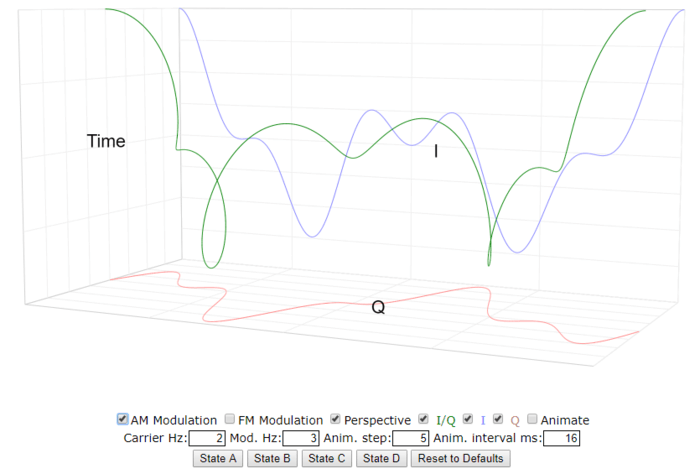An Intuitive Tutorial on SDR, The Frequency Domain and IQ Data
Over on his website P. Lutus has written up a useful article that introduces us to some common SDR hardware (RTL-SDRs, upconverters and the HackRF), mentions some common SDR software, and then dives into some SDR theory explaining concepts like the frequency domain and IQ sampling.
The theory sections in particular are explained quite intuitively with animated and interactive graphs that really help with visualizing the math. The explanations are short and not math heavy, so if you have half an hour you can learn some of the basic theory behind making SDRs work.

While the Author’s Web page is instructive regarding the relationship between I and Q signals with both amplitude and frequency modulation, it stops there and doesn’t go to the next step and show actual demodulation from the I/Q output.
The AM example helps lead the reader to concluding the AM demodulation process is fundamentally simple – by taking the root-sum-square of the I and Q signals. But this is not shown.
However for the ANALOG FM example, the animation shows the inherent problem with trying to demodulate FM from the I and Q signals. It’s not simple at all because the I and Q result is simply the representation of the FM modulated signal to begin with.
It seems to me that there is no simple way to go from the ANALOG FM modulated carrier frequency change to a demodulated analog amplitude change given I and Q, especially over a wide range of modulation frequencies relative to the carrier frequency. Hint: In the time-domain you need to derive the signal rate-of-change between samples, i.e., take the first derivative. (Of-course having higher sample rates and more computational power always helps, but that’s just a brute-force approach.)
But there are ways to do analog FM demodulation from the I and Q signals using digital signal processing. However it is (arguably) simpler to just fall back to analog FM demodulation techniques, especially for direct down-conversion I/Q (and to a lesser extent, low-IF I/Q down-conversion).
N.B., The discussion here targets analog FM. Other approaches should be easier for the likes of digital FM modulation (e.g., basic FSK).
Read more about the inherent difficulties associated with I/Q FM demodulation at these links:
1. Is it difficult to do FM demodulation digitally?
https://www.dsprelated.com/showthread/comp.dsp/142012-1.php
In the Reference-2 below, take a look at: “Figure 13–61. Frequency demodulator without arctangent: (a) standard process; (b) simplified process.”
2. DSP Tricks: Frequency demodulation algorithms
https://www.embedded.com/design/configurable-systems/4212086/DSP-Tricks–Frequency-demodulation-algorithms-
N.B., A printable version of the above link is available here:
https://www.embedded.com/print/4212086
Best 73’s, David WB4ONA
P.S., I would have left this comment on the Author’s Web page, but it seems that’s not possible.